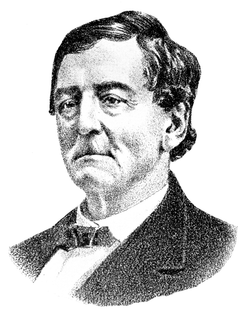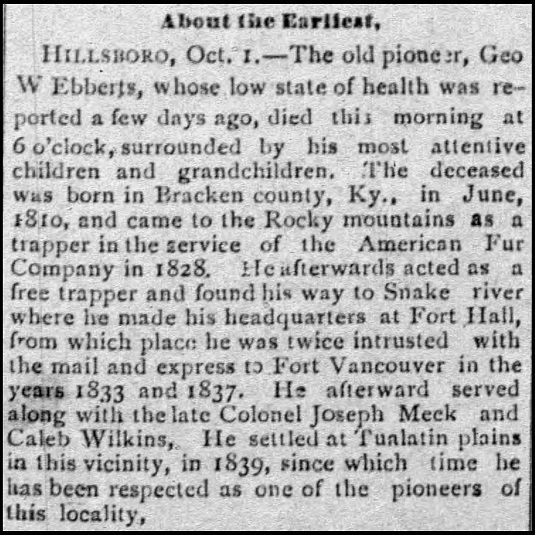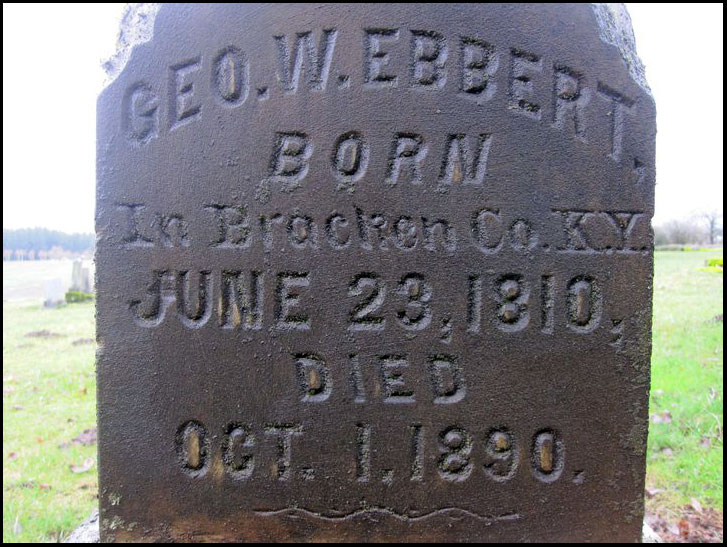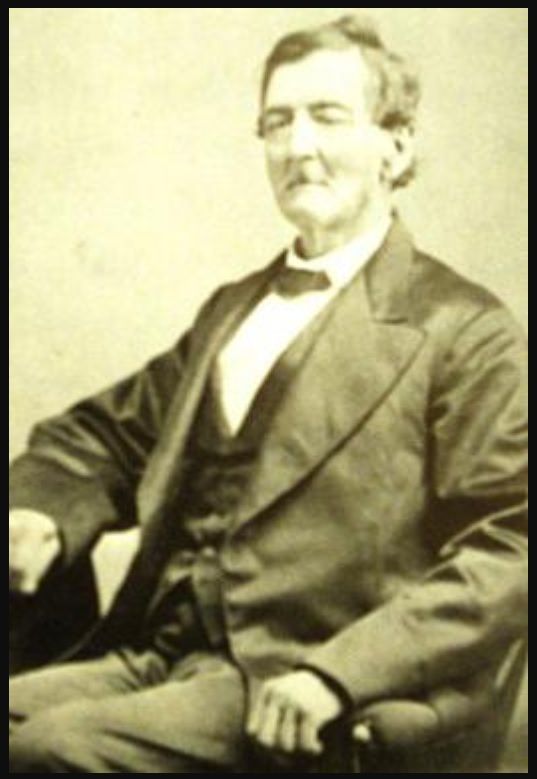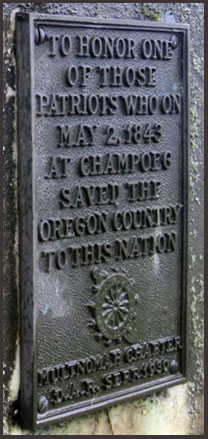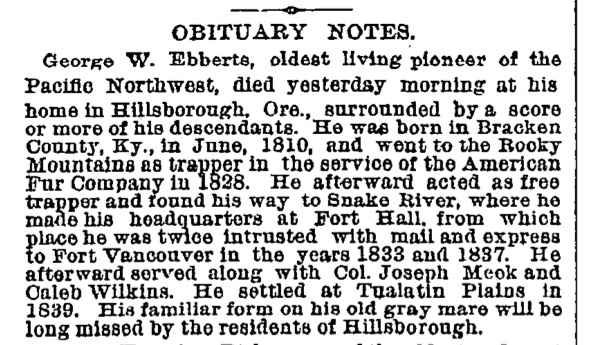" I was born in Bracken County, Kentucky, June 23, 1810, where I resided until early in the year of 1829, when I started for the Rocky Mountains in the employ of William Sublette to engage in the fur trade for the American Fur Company in whose employ I remained six years. I then joined the Hudson's Bay Company and trapped for that company three years. In the fall of 1838 I came to the Mission kept by the Rev. Mr. Spalding at Lapwai; remained there through that winter working at blacksmithing, a trade that I had learned in Kentucky. In the spring of 1839 I started for the Willamette Valley, arriving there on the 20th of May the same year, and settled at Champoeg for one year. I then moved to, the Tualatin Plains, twelve miles west of Portland, where I now reside, in the fall of 1841. In January, 1848, in company with the late Jos. L. Meek, Nathaniel Bowman, David Young, John Owens, James Stead, Samuel Miller, Jacob Leabo, Dennis Burriss, and a Mr. Jones, started for the States with dispatches for help from the parent Government."
Source: Autobiography of George W. Ebbert. Jan. 1877. The Quarterly of the Oregon Historical Society , Sep., 1918, Vol. 19, No. 3 (Sep.,
1918), pp. 263-267
______________________
At age thirteen he became an apprentice machinist and blacksmith. He went to St. Louis where he joined trapper Milton Sublette of the Rocky Mountain Fur Company and went to the Rocky Mountains where he became an independent beaver trapper or "free mountain man" beginning in about 1830. Beaver fur pelts were highly sought after by Europeans and Americans for hats which were in fashion during that era. Between 1837-1838 he also worked as a blacksmith at Fort Walla Walla, then the Whitman Mission at Waiilatpu, then the mission of Henry H. Spalding at Lapwai (Nez Perce).
Perhaps it was while he was at Lapwai he married a Nez Perce (Nimiipuu) woman whose given name is unknown, who he called "Fanny." While there, he stated that he had a good relationship with his wife's tribe. After 1838 the fashion demand for beaver fur hats declined and he and Fanny left for the Willamette Valley of "Oregon Country" arriving in 1839.
Ebbert and fellow former fur trappers Robert Newell, Caleb Wilkins and Joseph Meek, who, with their Nez Perce wives named Kitty, Catherine and Virginia, respectively, also came to the Willamette Valley where they each filed land claims during that time. Ebbert, Meek, and Wilkins had land claims here at the Tualatin Plains and were neighbors.
George and Fanny's Donation Land Claim, filed in both their names, was proofed in Jan 1844. They farmed wheat and oats and raised livestock for sale. Seed was initially provided by Dr. Mclaughlin of Oregon City. Ebbert also sold beaver pelts to the Hudson's Bay Company with his friend and neighbor Caleb Wilkins who also trapped here with him.
There were no wagon roads here at that time and all transport of goods was done on horseback. Being a machinist and blacksmith, Ebbert set up shop and sold plows and other equipment to others, including to the Mission at Oregon City. George and Fanny recorded their marriage at Washington County Oregon on 22 Jun 1843.
In 1843 he participated in the Champoeg Meetings at French Prairie (near present day Salem, Oregon) which were the first attempts at governance in the Pacific Northwest by European-American settlers. The meetings set in motion the first steps of a Provisional Government for the region.
In late 1847 following the Whitman Massacre at Waiilatpu and the ensuing Cayuse War, the Provisional Legislature of Oregon authorized Joe Meek to travel to Washington, DC. to notify Congress of the tragedy, to request assistance, and to ask Congress to create of a federal territory in Oregon Country. Ebbert accompanied Meek on that journey by horseback during the dead of winter starting out in January 1848.
On August 14, 1848 the United States Congress approved the formation of the Oregon Territory. At the time the Oregon Territory included all of the present day states of Oregon, Washington, Idaho, and parts of Montana and Wyoming.
Ebbert was one of the first purchasers of town lots in Hillsboro, Oregon. His land claim in Washington County was adjacent to what became the town of Orenco, Oregon and is the site of much of the Orenco Station development in Hillsboro.
" I was born in Bracken County, Kentucky, June 23, 1810, where I resided until early in the year of 1829, when I started for the Rocky Mountains in the employ of William Sublette to engage in the fur trade for the American Fur Company in whose employ I remained six years. I then joined the Hudson's Bay Company and trapped for that company three years. In the fall of 1838 I came to the Mission kept by the Rev. Mr. Spalding at Lapwai; remained there through that winter working at blacksmithing, a trade that I had learned in Kentucky. In the spring of 1839 I started for the Willamette Valley, arriving there on the 20th of May the same year, and settled at Champoeg for one year. I then moved to, the Tualatin Plains, twelve miles west of Portland, where I now reside, in the fall of 1841. In January, 1848, in company with the late Jos. L. Meek, Nathaniel Bowman, David Young, John Owens, James Stead, Samuel Miller, Jacob Leabo, Dennis Burriss, and a Mr. Jones, started for the States with dispatches for help from the parent Government."
Source: Autobiography of George W. Ebbert. Jan. 1877. The Quarterly of the Oregon Historical Society , Sep., 1918, Vol. 19, No. 3 (Sep.,
1918), pp. 263-267
______________________
At age thirteen he became an apprentice machinist and blacksmith. He went to St. Louis where he joined trapper Milton Sublette of the Rocky Mountain Fur Company and went to the Rocky Mountains where he became an independent beaver trapper or "free mountain man" beginning in about 1830. Beaver fur pelts were highly sought after by Europeans and Americans for hats which were in fashion during that era. Between 1837-1838 he also worked as a blacksmith at Fort Walla Walla, then the Whitman Mission at Waiilatpu, then the mission of Henry H. Spalding at Lapwai (Nez Perce).
Perhaps it was while he was at Lapwai he married a Nez Perce (Nimiipuu) woman whose given name is unknown, who he called "Fanny." While there, he stated that he had a good relationship with his wife's tribe. After 1838 the fashion demand for beaver fur hats declined and he and Fanny left for the Willamette Valley of "Oregon Country" arriving in 1839.
Ebbert and fellow former fur trappers Robert Newell, Caleb Wilkins and Joseph Meek, who, with their Nez Perce wives named Kitty, Catherine and Virginia, respectively, also came to the Willamette Valley where they each filed land claims during that time. Ebbert, Meek, and Wilkins had land claims here at the Tualatin Plains and were neighbors.
George and Fanny's Donation Land Claim, filed in both their names, was proofed in Jan 1844. They farmed wheat and oats and raised livestock for sale. Seed was initially provided by Dr. Mclaughlin of Oregon City. Ebbert also sold beaver pelts to the Hudson's Bay Company with his friend and neighbor Caleb Wilkins who also trapped here with him.
There were no wagon roads here at that time and all transport of goods was done on horseback. Being a machinist and blacksmith, Ebbert set up shop and sold plows and other equipment to others, including to the Mission at Oregon City. George and Fanny recorded their marriage at Washington County Oregon on 22 Jun 1843.
In 1843 he participated in the Champoeg Meetings at French Prairie (near present day Salem, Oregon) which were the first attempts at governance in the Pacific Northwest by European-American settlers. The meetings set in motion the first steps of a Provisional Government for the region.
In late 1847 following the Whitman Massacre at Waiilatpu and the ensuing Cayuse War, the Provisional Legislature of Oregon authorized Joe Meek to travel to Washington, DC. to notify Congress of the tragedy, to request assistance, and to ask Congress to create of a federal territory in Oregon Country. Ebbert accompanied Meek on that journey by horseback during the dead of winter starting out in January 1848.
On August 14, 1848 the United States Congress approved the formation of the Oregon Territory. At the time the Oregon Territory included all of the present day states of Oregon, Washington, Idaho, and parts of Montana and Wyoming.
Ebbert was one of the first purchasers of town lots in Hillsboro, Oregon. His land claim in Washington County was adjacent to what became the town of Orenco, Oregon and is the site of much of the Orenco Station development in Hillsboro.
Inscription
Geo. W. Ebbert.
Born in Bracken Co. Kentucky
June 23rd 1810.
Died
Oct. 1, 1890.
Family Members
Advertisement
Advertisement
